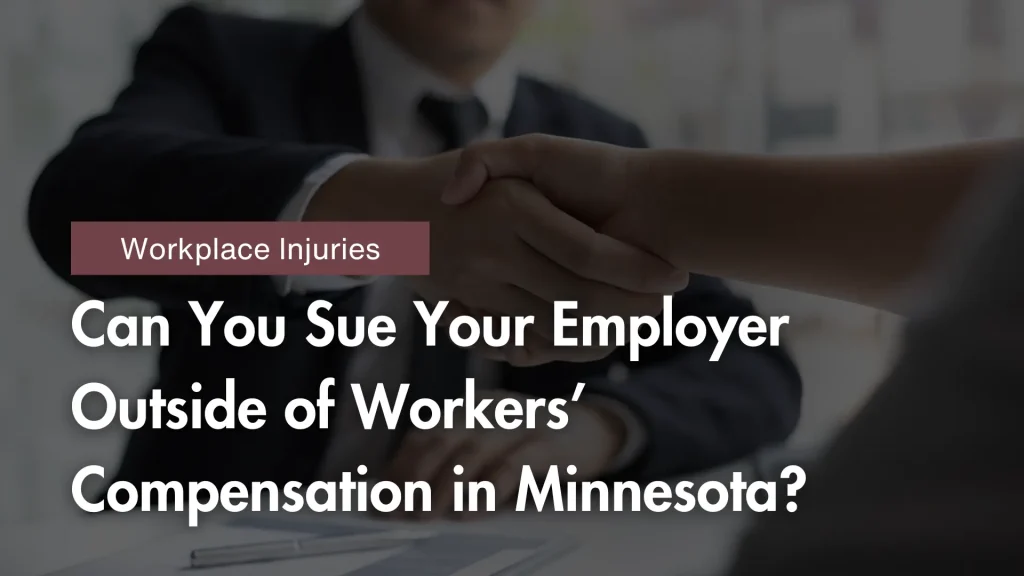
In most workplace injury cases, Minnesota law limits your legal remedy to workers’ compensation benefits. This system helps injured employees recover medical costs and lost wages without needing to prove fault. But what happens when your employer crosses a legal line? Can you step outside the workers’ compensation system and file a lawsuit? Sometimes, suing an employer outside workers’ compensation may be possible—but it depends on the circumstances.
The short answer: In rare and specific situations, yes. Here’s a closer look at what those exceptions involve – and when an employee might have grounds to sue an employer outside the workers’ comp system.
Workers’ Compensation in Minnesota: The Default Rule
Minnesota’s workers’ compensation system operates under what’s known as the exclusivity rule. That means if you get hurt on the job, your employer covers certain benefits, and you give up the right to sue in most cases. You don’t need to prove your employer did anything wrong—just that the injury happened at work or during employment. However, there are certain situations when you can sue outside of workers’ compensation, depending on the details of your case—and in those cases, a settlement may offer compensation beyond what workers’ comp typically provides.
However, this coverage has limits. Workers’ compensation doesn’t account for emotional losses, long-term suffering, or complete financial recovery when negligence goes beyond carelessness. That’s why it’s essential to understand when the law allows legal action beyond workers’ compensation matters.
When Can You Sue an Employer Outside of Workers’ Compensation in Minnesota?
Some exceptions to workers’ comp exclusivity exist. These scenarios typically involve intentional harm, extreme misconduct, or dual legal roles.
Intentional Harm or Gross Misconduct
If your employer intentionally caused you harm, such as through workplace assault, threats, or gross negligence, you may be able to file a civil lawsuit. This is not easy to prove. You’ll need evidence that your employer acted with intent or willful disregard for your safety.
For example, suppose you suffered an injury because your employer knowingly violated serious safety standards or refused to fix defective equipment after repeated warnings. You might have grounds to sue for unsafe work conditions in that case. These rare cases require strong documentation and legal support.
Dual Capacity Doctrine
The dual capacity doctrine applies when your employer serves in multiple legal roles. Say your employer also manufactured the toxic substance that caused your illness. In that case, you may have a separate product liability claim apart from your employer-employee relationship.
Employer Retaliation
If your employer retaliates against you for filing a workers’ compensation claim – by demoting, firing, or harassing you – you can pursue an employer retaliation lawsuit. Minnesota law protects workers from these actions, and you have the right to seek a legal remedy.
Emotional Distress or Assault Claims
In rare instances, you might sue for emotional distress or workplace personal injury that goes beyond a physical work accident. This could involve repeated harassment, workplace assault, or employer misconduct, creating a hostile work environment.
Each of these exceptions requires a legal strategy grounded in state-specific precedent. Working with a knowledgeable attorney can help you understand which path fits your situation.
What If My Employer Isn’t a Workers’ Comp Policyholder?
Most Minnesota employers must carry workers’ compensation insurance. However, if your employer doesn’t comply, you may file a non-subscriber employer injury claim under Minnesota law. This type of lawsuit resembles a standard personal injury claim and allows for a broader recovery of losses.
Remember that Minnesota law also imposes strict time limits if you pursue legal action beyond workers’ comp. Acting quickly can preserve your options.
Third-Party Lawsuits in Minnesota Workplace Injury Cases
 Even if your employer remains protected by workers’ comp, other parties might not be. This opens the door to a third-party claim – a lawsuit against someone other than your employer whose actions contributed to your injury. Common examples include:
Even if your employer remains protected by workers’ comp, other parties might not be. This opens the door to a third-party claim – a lawsuit against someone other than your employer whose actions contributed to your injury. Common examples include:
- A manufacturer whose defective equipment malfunctioned on the job
- A contractor or subcontractor who created a hazardous worksite
- A property owner who failed to maintain safe conditions
Say you were hurt on a construction site due to faulty scaffolding made by an outside company. In that case, you may be able to file a civil lawsuit for your losses while still receiving workers’ comp benefits from your employer. This dual strategy helps cover losses that workers’ comp does not address.
In toxic exposure workplace claims, third-party manufacturers of chemicals or machinery may also be liable, especially when long-term illnesses like cancer or neurological conditions develop.
Talk to a Minneapolis Work Injury Attorney About Your Legal Options
If your injury involves employer liability or a third party, you may have options beyond workers’ comp in Minnesota. At Robert Wilson & Associates, we help injured workers explore civil lawsuits, third-party claims, and employer negligence cases.
Our team is here to help you understand your rights and take the first step toward securing the necessary benefits.
Call (612) 334-3444 or contact us online for a free consultation.
Related Post
What a Workers’ Compensation Records Request Reveals About You
What’s Different in Monopolistic Workers’ Compensation States?